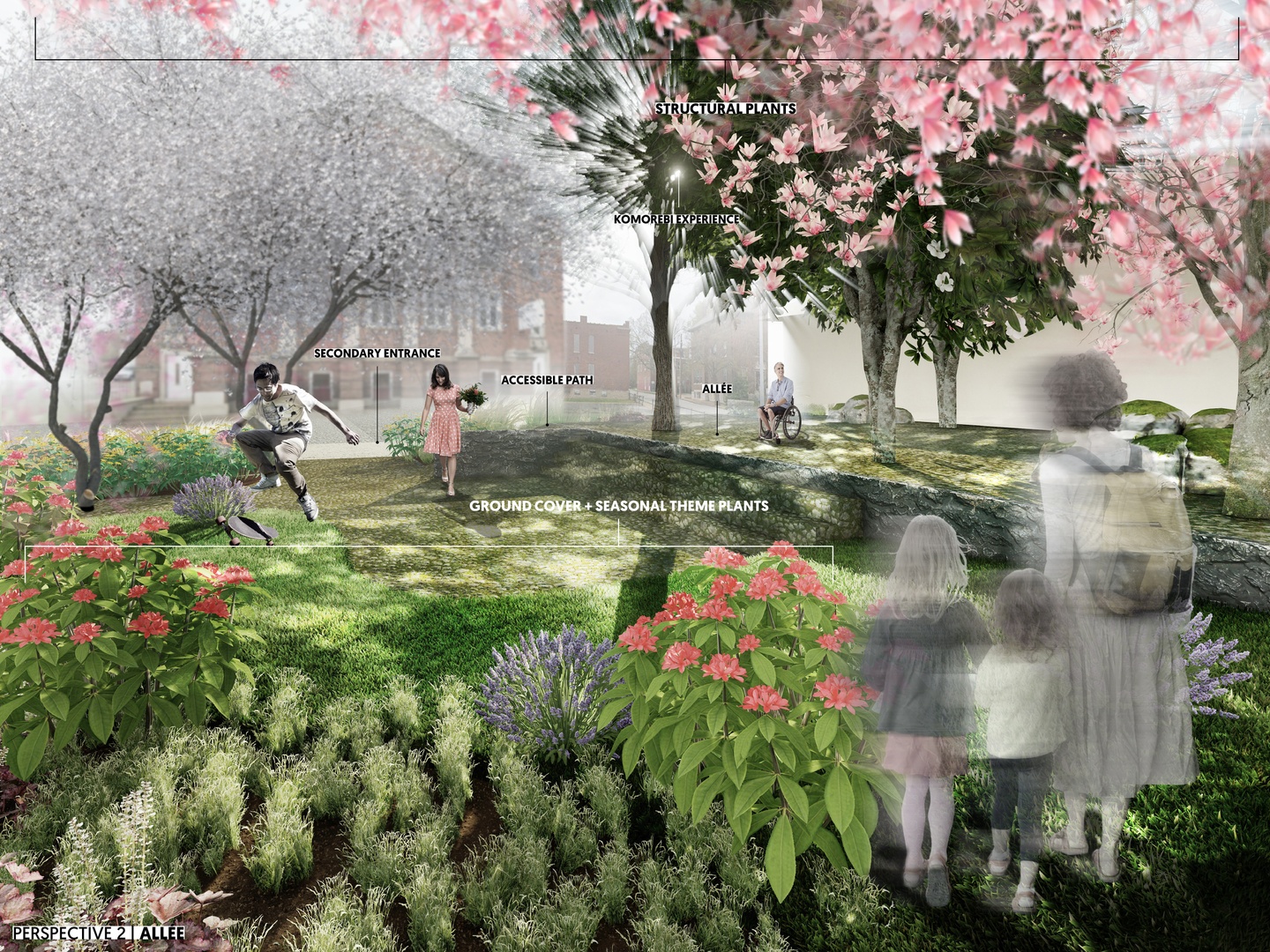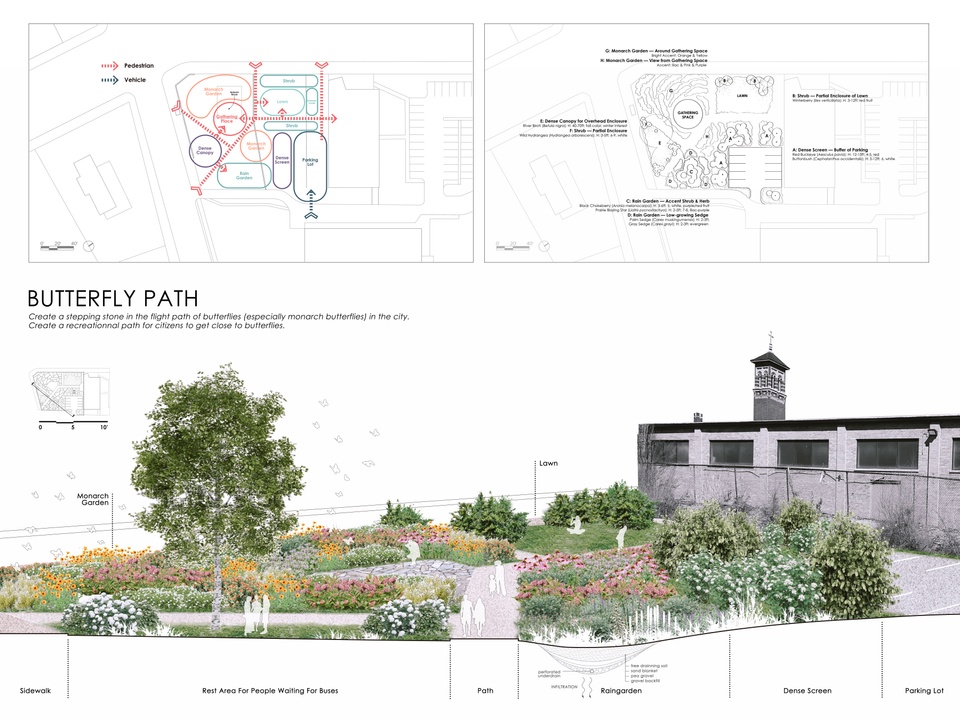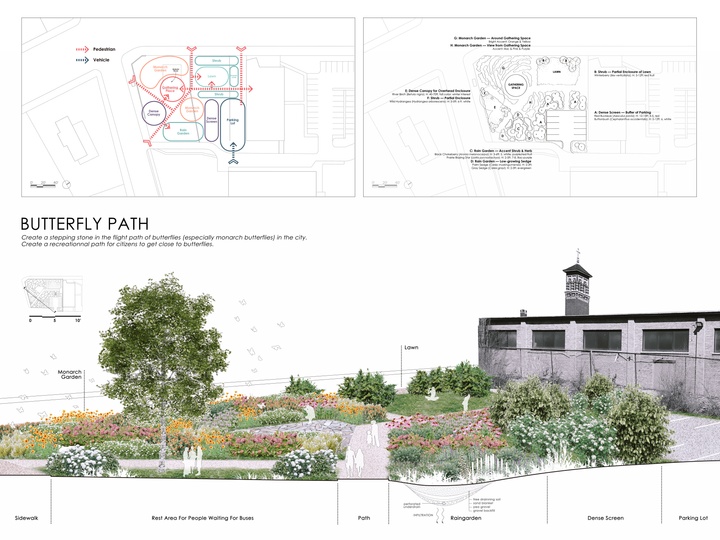Planting Design
2021-07-06 • Liz Kramer

Perspective rendering created by Chinh Pham
Spring 2021 landscape architecture seminar led by lecturer Alexandra Mei
Plants are part of the core of landscape architecture, and the design of plant communities is central to a landscape architect’s ability to respond to a site’s ecology and natural systems. In this course, landscape architecture students applied and expanded their knowledge of plant material to the construction of landscapes, prioritizing the health and sustainability of the local environment.
Throughout the course, students took on exercises to approach the comprehensive process of designing a plant environment, from site exploration through planting plans and documentation. In spring 2021, students explored design proposals for a site in the College Hill neighborhood in North St. Louis, located at the corner of E. Grand Boulevard and Florissant Avenue. The vacant lot was selected through a partnership with the Urban League of Metropolitan St. Louis, and a prime candidate for a new vision.
“Through the Planting Design course, we had the wonderful opportunity to work with the Urban League to envision what their site could look like,” said lecturer Alexandra Mei (BA15), instructor for the course. “This was such a fun project to work on, as the students were able to propose design ideas that might be implemented in the near future, while contending with real site concerns such as parking, circulation, and the Urban League’s programmatic desires for their site.”
The course was organized into three phases — place, people, and plants — allowing students to build on their knowledge systematically. Starting with place, students studied six key features of the surrounding area: climate, flora/fauna, invasive species, hydrology, soils, and history. This study overlapped with the study of the specific place, zeroing in on the site itself.
“What I found the most compelling about this class is that it provided us with an actual client and organization that we were tasked to design for,” said March/MLA dual degree candidate Kaiti Burger. “This afforded us a glimpse into how landscape architecture is actually practiced, but with the freedom of design that is encouraged while still in a studio setting. The creation of the final planting plan helped me to better understand the spatiality of my design, the impacts of the selected plant species, and how it all can come together to create a cohesive, beautiful experience for the users of the space.”
The course was hybrid, due to the pandemic, but Burger was able to visit the site in person, which provided her greater contextual understanding. “I saw how the site was currently being utilized by the public and knew that I wanted to foster community interaction from the beginning,” Burger said. “Therefore, the design intent of my project was to create a landscape that was representative of the Urban League and its needs, but also inviting to the rest of the community by providing an inclusive space for gathering, strolling, or even waiting for the bus.”
After studying the area closely, students investigated the interactions of people, including the way the existing site facilitated opportunities, constraints, circulation, and desired atmosphere. Each week, the students produced drawings exploring that area of study, building on the prior work as they approached the final phase: plants. The final products included a planting plan with selected plants, section perspectives showing topographical changes, stormwater management systems, and a rendering of the impact of the selected plants.
MLA student Chinh Pham found the opportunity to explore the more organic language of plants in the context of community to be beneficial. “This course widened my horizons on landscape architecture,” said Pham. “I became more open to softer and organic design approaches, after previous study and work that was architecturally intensive and closely prescribed. I used the soft and organic language of plants to address a serious situation, which really challenged my design habits.” Pham’s project responded to the crime rate in the surrounding College Hill neighborhood by maximizing the transparency of the landscape to help minimize potential crimes in an area that would otherwise be opaque.
Throughout the course, students engaged virtually with the Urban League, connecting with Michael Foley, who was previously the senior director of development at Urban League of Metropolitan Saint Louis, Inc., and is now the assistant director at Citizens for Modern Transit.
“I greatly enjoyed the opportunity to work with the Planting Design class this past semester,” said Foley. “The class took the time to listen to the history of the site and really understood the overall plan for the future. The plans took into account things that we had not even considered, such as the sun/shade ratio on the property. It was obvious that each student put a lot of time and effort into reviewing all aspects of the site before putting together their various planting designs. The final presentations were detailed and showed the depth of knowledge that the students brought to the project.”
“The students jumped in very quickly, having only seven weeks to research, analyze, design and refine their proposals, and their enthusiasm and commitment to the site was really evident in each of their projects,” Mei added.
This final work was shared with partners from the Urban League to help inspire their future work. In addition, Mei will continue this partnership with the Urban League in the 2021-2022 academic year as she leads a team of students in the Sustainability Exchange, who will develop and apply for grant funding for this site based on the Planting Design students’ work.















